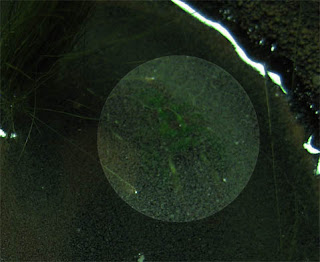
It came out a lot darker than I wanted, and it's much more opaque than I'd hoped, but it's a great effect. I still have another layer of water to put down, and the standing tree isn't done yet. I think this one will end up looking better than the first by a wide margin at this rate.

I think this proved my point! The Envirotex Lite is still wet -- it won't be set enough for me to work it for at least another day -- but it's looking amazing. There's a real sense that the water is disgusting and unpalatable; the creature looks like it's surfacing just slightly.
 It's still not as clear as I'd like. In my experimental runs, the Envirotex started cloudy and cleared as it dried, but even if it doesn't clear up at all, that's OK -- this still looks wonderful. Some water effects will add ripples to the beast, and the tall tree will get some gray and then white highlights. I really need to finish some bog trogs before I go and start my next template, but that one's going to be idyllic -- pretty rocks, nice grass, perhaps some catty wampus, and clear water with fish and crawdads (again).
It's still not as clear as I'd like. In my experimental runs, the Envirotex started cloudy and cleared as it dried, but even if it doesn't clear up at all, that's OK -- this still looks wonderful. Some water effects will add ripples to the beast, and the tall tree will get some gray and then white highlights. I really need to finish some bog trogs before I go and start my next template, but that one's going to be idyllic -- pretty rocks, nice grass, perhaps some catty wampus, and clear water with fish and crawdads (again).























